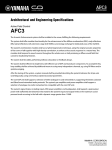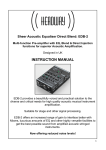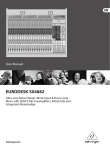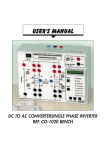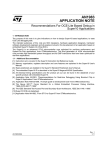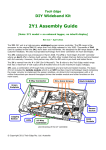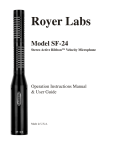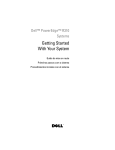Download DN 3816 - bel aqustic
Transcript
DN 3816 Digital audio 8x16 EtherSound Matrix SOMMAIRE 6 7 8 3 3 3 4 4.1 Public-Address Matrix.............................................................................................................................. 4 4.2 Audio signal transportation application .................................................................................................... 5 4.3 Use of « Matrix Control » ......................................................................................................................... 7 PRESENTATION ................................................................................................................................................... 7 5.1 DN 3816 matrix package contents........................................................................................................... 7 5.2 Front panel .............................................................................................................................................. 7 5.2.1 Ventilation grill ................................................................................................................................. 7 5.2.2 Green power ON indicator ............................................................................................................... 7 5.2.3 Green STATUS indicator ................................................................................................................. 7 5.2.4 Green input SIGNAL indicators........................................................................................................ 7 5.2.5 Red input CLIP indicators ................................................................................................................ 7 5.2.6 Green output SIGNAL indicators ..................................................................................................... 7 5.2.7 Red output CLIP indicators .............................................................................................................. 7 5.2.8 RS232 socket .................................................................................................................................. 7 5.2.9 Network activity leds ........................................................................................................................ 7 5.3 Rear panel .............................................................................................................................................. 8 5.3.1 NETWORK connector...................................................................................................................... 8 5.3.2 CONSOLE connector ...................................................................................................................... 8 5.3.3 GP Inputs connector block............................................................................................................... 8 5.3.4 GP Outputs connector block ............................................................................................................ 8 5.3.5 Serial Number label ......................................................................................................................... 8 5.3.6 Analog Inputs 1 to 8......................................................................................................................... 8 5.3.7 Analog Outputs 1 to 16 .................................................................................................................... 8 5.3.8 24 V socket...................................................................................................................................... 8 5.3.9 MAC address ................................................................................................................................... 8 5.3.10 Ground point.................................................................................................................................... 8 5.3.11 Mains block...................................................................................................................................... 8 5.3.12 ON / OFF switch .............................................................................................................................. 8 INSTALLATION .................................................................................................................................................... 9 6.1 Block diagram of the DN 3816 audio channels........................................................................................ 9 6.1.1 Mic/Line audio inputs (1 to 4)........................................................................................................... 9 6.1.2 Line audio inputs (5 to 8) ................................................................................................................. 9 6.1.3 Audio outputs (1 to 16) .................................................................................................................... 9 CABLING, CONNECTIONS AND STARTING UP THE DN 3816 .................................................................... 9 7.1 Mains power connection .......................................................................................................................... 9 7.2 +24 V power supply ................................................................................................................................. 9 7.3 Audio input and output connections....................................................................................................... 10 7.4 Connecting to EtherSound Network....................................................................................................... 10 7.5 Connecting GX 3016 consoles and an RS232 serial control device...................................................... 10 7.6 Connecting an RS232 serial control device to the Data Link ................................................................. 11 7.7 RS232 socket on the front panel............................................................................................................ 11 7.8 Logic GPI (General Purpose Input) wiring ............................................................................................. 11 7.8.1 Using GPIs..................................................................................................................................... 12 7.9 Logic GPO (General Purpose Output) wiring......................................................................................... 12 7.9.1 Using GPOs................................................................................................................................... 12 7.10 Starting up the DN 3816 ........................................................................................................................ 12 CONFIGURING THE DN 3816 ...................................................................................................................... 13 8.1 Hardware configuration: setting the physical parameters of the audio inputs ........................................ 13 8.2 Software configuration ........................................................................................................................... 14 8.2.1 Functional definition....................................................................................................................... 14 480 avenue de Paris –82000 MONTAUBAN France Tél. 33 (0)5 63 21 30 00 – Fax : 33 (0) 5 63 03 08 26 –http://www.bouyer.com FR 12352375877 - 352 375 877 RCS MONTAUBAN Specifications subject to modification without notice. 5 INTRODUCTION ................................................................................................................................................... GENERAL TECHNICAL SPECIFICATIONS .................................................................................................................. GENERAL DESCRIPTION ....................................................................................................................................... APPLICATIONS ................................................................................................................................................... Code 596374 – 06/09 1 2 3 4 8.2.1.1 Setting the audio input source parameters ...................................................................... 14 8.2.1.1.1 Modulation detection ....................................................................................................... 15 8.2.1.1.2 DAS channel 1 and channel 2 ......................................................................................... 15 8.2.1.1.3 Persistent ........................................................................................................................ 15 8.2.1.1.4 GPI remote control .......................................................................................................... 15 8.2.1.1.5 GX 3016 .......................................................................................................................... 15 8.2.1.1.6 Modulation Detection parameters.................................................................................... 15 8.2.1.1.6.1 Detection threshold .................................................................................................... 15 8.2.1.1.6.2 Detection time ............................................................................................................ 15 8.2.1.1.6.3 Release time .............................................................................................................. 15 8.2.1.2 Prioritising audio inputs according to audio outputs ........................................................ 15 8.2.1.3 Setting the Group parameters ......................................................................................... 16 8.2.1.4 Setting the GX 3016 console key parameters ................................................................. 16 8.2.1.5 Setting the GPI parameters ............................................................................................. 16 8.2.1.5.1 Remote Control ............................................................................................................... 16 8.2.1.5.2 Day/Night......................................................................................................................... 16 8.2.1.5.3 Mute ................................................................................................................................ 16 8.2.1.6 Setting the GPO parameters ........................................................................................... 16 8.2.1.6.1 Broadcast in progress...................................................................................................... 17 8.2.2 Setting the digital process parameters........................................................................................... 17 8.2.2.1 Input audio adjustments .................................................................................................. 17 8.2.2.1.1 Using Noise Gate on audio inputs ................................................................................... 17 8.2.2.1.2 Setting Bass/Treble on audio inputs ................................................................................ 17 8.2.2.1.3 Setting Mute on the audio inputs ..................................................................................... 17 8.2.2.1.4 Adjusting Volume on the audio inputs ............................................................................. 17 8.2.2.2 Output audio adjustments................................................................................................ 17 8.2.2.2.1 5 band parametric equaliser ............................................................................................ 17 8.2.2.2.1.1 Frequency Fc ............................................................................................................. 17 8.2.2.2.1.2 Quality Factor Q ......................................................................................................... 17 8.2.2.2.1.3 Gain G........................................................................................................................ 18 8.2.2.2.1.4 N.B.: The effect of equalisation on voice sounds ....................................................... 18 8.2.2.2.2 Setting Mute on the audio outputs................................................................................... 18 8.2.2.2.3 Adjusting Delay on the audio outputs .............................................................................. 18 8.2.2.2.4 Adjusting Volume on the audio outputs ........................................................................... 18 9 MONITORING THE DN 3816 SWITCH MATRIX STATUS ............................................................................ 18 9.1 Monitoring audio levels .......................................................................................................................... 18 9.2 Verifying the DN 3816’s switch matrix routing ....................................................................................... 18 9.3 Monitoring GPI status ............................................................................................................................ 18 9.4 Monitoring GPO status .......................................................................................................................... 18 10 DETAILED TECHNICAL SPECIFICATIONS ............................................................................................ 20 10.1 Audio inputs........................................................................................................................................... 20 10.2 Audio outputs......................................................................................................................................... 20 10.3 A to D converter specifications .............................................................................................................. 20 10.4 D to A converter specifications .............................................................................................................. 20 10.5 Audio specifications ............................................................................................................................... 20 10.6 EtherSound............................................................................................................................................ 20 10.7 GPI Specifications ................................................................................................................................. 20 10.8 GPO Specifications................................................................................................................................ 20 10.9 Mains Power Supply .............................................................................................................................. 20 10.10 +24 Volt Power Supply .......................................................................................................................... 20 10.11 GX 3016 Power Supply ......................................................................................................................... 20 10.12 Mechanical Specifications ..................................................................................................................... 20 11 RECOMMENDATIONS ............................................................................................................................. 20 12 APPENDICES ........................................................................................................................................... 21 12.1 Factory Settings..................................................................................................................................... 21 12.1.1 Hardware Configuration................................................................................................................. 21 12.1.2 Default configuration of the audio input source types .................................................................... 21 12.1.3 Default configuration of priority levels ............................................................................................ 21 12.1.4 Default configuration of groups ...................................................................................................... 22 12.1.5 Default configuration of the GX 3016 keys .................................................................................... 22 12.1.6 Default configuration of logic GPIs................................................................................................. 22 12.1.7 Default configuration of logic GPOs............................................................................................... 23 12.1.8 Default configuration of the sound detection parameters............................................................... 23 12.1.9 Default values of the audio signal processing parameters............................................................. 23 12.1.10 Default values for the delay parameters ........................................................................................ 23 2 DN3816 1 INTRODUCTION The DN3816 matrix is a low-level switching matrix which uses EtherSound technology ; by using bidirectionnal transmission of 64 digital channels (24bits coding, sampling 48Khz), this technology gives possibility to build audio matrix on a dedicated 100 Mb/s LAN network. Because this technology is totally compliant with Ethernet 802.3x requirements, all compliant components (switches, Cat5 cable, optic fiber, …) can be used to build the EtherSound network (layer 2 level). Internal processing and signal processing are fully digital, using SHARC© Digital Signal Processing (DSP) technology. DSP technology provides the DN 3816 matrix with a wide range of audio signal processing options and at the same time allows extremely flexible configuration. This product is designed for using in applications where several high quality audio sources need to be selected and broadcasted to several audio outputs. 2 GENERAL TECHNICAL SPECIFICATIONS The matrix has the following features: • 8 audio analogue inputs • 16 audio analogue outputs • 8 logic inputs • 16 logic outputs • 1 x RS232 interface for use by configuration application “Matrix Control” • 1 x dual RS485 interface for bus console management (GX3016, GXT4000, …) • 1 x RS232 interface for communication with external equipment. • 1 x EtherSound interface The following digital audio processes can be applied to each audio input : • level adjustment • bass/treble • adjustable noise gate • mute The following digital audio processes can be applied to each audio output: • level adjustment • 5 band parametric equaliser • mute • delay (up to 5s for each output) 3 GENERAL DESCRIPTION The DN 3816 is a programmable digital audio routing matrix with a wide range of features and applications. Basically, the DN 3816 can be used to switch 8 audio input channels to 16 audio output channels. Switching may be triggered in a number of ways including according to audio input priority levels. The DN 3816 also offers audio signal processing such as sound detection, noise gate, tone adjustment and a 5 band parametric equaliser. Two console buses (GX 3016, GXT 4000, …) can be connected to a single DN 3816 for broadcasting spoken announcements to one or more audio output channels. In addition, the matrix has 8 general purpose logic inputs (logic GPIs) and 16 general purpose logic outputs (logic GPOs). The logic GPIs provide dynamic switching control of the 8 audio input channels to the 16 audio output channels. The logic GPOs are used to provide information on the status of the matrix to other system equipment. The matrix will run off either 230V AC. or off 24V DC using a suitable transformer. 3 DN3816 4 4.1 APPLICATIONS Public-Address Matrix Basically equipped with 8 inputs and 16 outputs, the DN3816 is designed to build all size audio switching matrix of which exploitation is managed by an application server (consult Bouyer for details explanations). Due to the design, the DN3816 has a mixed operating mode ; that means that some actions can be dedicated to the DN 3816 (by preliminary settings) without intervention of the server application ; in this case, the server application is notified by the DN 3816 when actions are achieved ; this is possible, for example, when a source switching is always operated on one or several zones of the same matrix and when the triggering of this action is managed by the matrix (local console, local remote, …). Design example : 24 inputs and 48 outputs audio matrix LAN Ethernet IP Sources 1 à 8 / 1 to 8 sources EtherSound Network Zones 1 à 16 / 1 to 16 zones Sources 9 à 16 / 9 to 16 sources DN3816 EtherSound Network Reseau EtherSound / Reseau EtherSound / DN3816 Serveur d’application / Application server Zones 17 à 32 / 17 to 32 zones Sources 17 à 24 / 17 to 24 sources DN3816 Zones 33 à 48 / 33 to 48 zones 4 DN3816 4.2 Audio signal transportation application The DN3816 matrix can be used to achieve audio signal transportation between 2 or several distant places through an Ethernet link. This functionality doesn’t require any application server. In all cases, transported signals benefit from all audio processing : - volume, bass/treble, noise gate (settings to do on inputs side) - volume, 5 band equalization, delay (settings to do on outputs side) Example n°1 : transportation of 16 audio signals between 2 distant places through optic fiber link. Network IN 8 signaux audios 1à8 / 8 audio signals 1 to 8 DN3816 NetworkOUT Fibre Optique/Ethernet / Fiber optic to Ethernet Network IN 8 signaux audios 1 à 8 / 8 audio signals 1 to 8 DN3816 NetworkOUT 8 signaux audios 9 à 16 / 8 audio signals 9 to 16 Network IN 8 signaux audios 9 à 16 / 8 audio signals 9 to 16 NetworkOUT Lieu A / Place A 5 Fibre optique / Optic fiber DN3816 Ethernet/Fibre Optique / Ethernet to fiber optic Lieu B / Place B DN3816 Exemple n° 2 : transportation of 8 audio signals from 1 place to 4 distant places through optic fiber link Fibre Optique/Ethernet / Optic fiber to Ethernet Network IN 8 signaux audios 1 à 8 / 8 audio signals 1 to 8 DN3816 Ethernet/Fibre Optique / Ethernet to optic fiber 8 signaux audios 1à8 / 8 audio signals 1 to 8 Network OUT Network IN DN3816 Network OUT Switch Ethernet / Ethernet switch Ethernet/Fibre Optique / Ethernet to optic fiber Ethernet/Fibre Optique / Ethernet to optic fiber Fibre Optique/Ethernet / Optic fiber to Ethernet Network IN 8 signaux audios 1 à 8 / 8 audio signals 1 to 8 DN3816 Fibre optique / Optic fiber Network OUT Ethernet/Fibre Optique / Ethernet to optic fiber Fibre Optique/Ethernet / Optic fiber to Ethernet Network IN 8 signaux audios 1 à 8 / 8 audio signals 1 to 8 DN3816 Network OUT Lieu A / Place A Fibre Optique/Ethernet / Optic fiber to Ethernet Network IN DN3816 Network OUT Lieux distants / Distant places 6 DN3816 8 signaux audios 1 à 8 / 8 audio signals 1 to 8 4.3 Use of « Matrix Control » « Matrix Control » is a software application to do all settings of one DN3816 (audio inputs settings, audio outputs settings, priority level, source types, GPI and GPO settings) through a RS232 link (help document included in « Matrix Control » shows also how to use this software to do all the settings through a TCP/IP connexion by using an external IP/RS converter). Depending on the application in use on the application server, « Matrix Control » can be optional or compulsory. Details for using “Matrix Control” are given in §0 (Configuring the DN3816). 5 5.1 5.2 5.2.1 5.2.2 5.2.3 5.2.4 5.2.5 5.2.6 5.2.7 5.2.8 5.2.9 PRESENTATION DN 3816 matrix package contents The DN 3816 matrix is delivered complete with the following: • One DN 3816 Matrix • One User Manual (this document) • One CD-ROM containing the « Matrix Control » installation software • One 230 V AC mains power lead • Twelve 6-pin audio connectors • Six 5-pin GPI and GPO connectors • One RS232 serial cable for connection to a PC (1.80 m length) Before using the DN 3816, first check that none of the items are missing from the package. Front panel Ventilation grill This allows the free circulation of air inside the unit, thus ensuring the internal electronic components do not overheat. Green power ON indicator When lit, the unit is powered on. Green STATUS indicator When lit, this indicates that the digital signal processing and control functions of the DN 3816 matrix are working correctly. Green input SIGNAL indicators These indicators light when an audio signal of more than -20 dBm is present at the corresponding inputs. Red input CLIP indicators These indicators light when an audio signal of more than -6 dBFS (or 14 dBm) is present at the corresponding input. For information, 0 dBFS is the absolute maximum acceptable level the digital signal processor input can handle. Green output SIGNAL indicators These indicators light when an audio signal of more than -20 dBm is present at the corresponding output. Red output CLIP indicators These indicators light when an audio signal of more than -6 dBFS (or 14 dBm) is present at the corresponding output. For information, 0 dBFS is the absolute maximum acceptable level the digital signal processor can handle. RS232 socket This 9-pin SUB-D female connector is used to connect a PC to the DN 3816 so the unit can be configured using the « Matrix Control » configuration software supplied. This connection is also used to update the DN 3816 firmware as necessary. Network activity leds The 4 leds In (Rx, Tx) et Out (Rx, Tx) give information on the network activity in the 2 directions Rx and Tx on the EtherSound network interfaces (In et Out). A blinking led indicates network activity. Network In Out Rx Tx DN 3816 7 DN3816 5.3 Rear panel 5.3.1 NETWORK connector These connectors (In et Out) are used to connect the DN3816 matrix to the EtherSound network ; the In connector is used to receive the incoming EtherSound Stream and the Out connector is used to transmit the outgoing stream. 5.3.2 CONSOLE connector The Console 1 and Console 2 RJ45 connectors are used to connect two console buses (GX 3016, GXT 4000) to the unit. The Console 2 connector also has an RS232 serial Data Link for connecting an additional control device. 5.3.3 GP Inputs connector block The GP Inputs block comprises 8 opto-isolated logic inputs. 5.3.4 GP Outputs connector block The GP Outputs block consists of 16 open-collector logic outputs. 5.3.5 Serial Number label The label displays the serial number of the DN 3816. 5.3.6 Analog Inputs 1 to 8 The analogue inputs connector strip consists of 8 balanced analogue audio inputs. 5.3.7 Analog Outputs 1 to 16 The analogue outputs connector strip consists of 16 balanced analogue audio outputs. 5.3.8 24 V socket This socket allows the unit to be powered using a 24V DC direct current supply instead of a 230V AC mains supply. 5.3.9 MAC address This information is the MAC address of the DN3816 (used for software settings on application server. 5.3.10 Ground point Use this connector to ground the DN 3816 matrix to earth when fitting the unit inside a rack cabinet. In certain circumstances, earthing the unit will considerably reduce hum, noise and interference. 5.3.11 Mains block The earthed mains block should be used to connect the DN3816 to a suitable 230V AC mains supply using the lead provided. 5.3.12 ON / OFF switch The ON/OFF switch on the mains block should be used to power the DN 3816 on and off. 8 DN3816 6 INSTALLATION The unit comes complete with everything needed to mount it into a 19” rack. Just four M6 screws are used to rack the unit. The DN 3816 must not be exposed to water (through splashing, from condensation, etc.). Ensure the front and rear ventilation grills are kept clear at all times and that air flow around the unit is not restricted. Ensure there is sufficient room at the rear of the unit (at least 100 mm) to connect the cables. Warning 6.1 Block diagram of the DN 3816 audio channels 6.1.1 Mic/Line audio inputs (1 to 4) DSP Vu-mètre/ Vumeter Entrée audio/ Audio input 6.1.2 Détec. Niveau/ Level detection Pré-ampli Mic / Ligne Mic/Line preamp Noise Gate Tonalité Tone Volume Canal DSP/ DSP channel Mute Line audio inputs (5 to 8) DSP Vu-mètre/Vumeter Entrée audio/ Audio input 6.1.3 Transformateur Transformer Détec. Niveau Level detection Pré-ampli Ligne Line preamp Noise gate Tonalité Tone Volume Mute Canal DSP/ DSP channel Audio outputs (1 to 16) DSP Vu-mètre/ Vumeter Canal DSP/ DSP channel 7 7.1 7.2 Routage/ Routing Egaliseur/ Equaliser Volume Jour/Nuit Day/Night Mute Preampli de sortie/ Output preamp Sortie audio/ Audio output CABLING, CONNECTIONS AND STARTING UP THE DN 3816 Mains power connection The DN 3816 is 230V AC mains powered using the power cable supplied. +24 V power supply The DN 3816 may also be powered using a 24 V d.c. 60 W (minimum) power supply connected to the +24 V two pin connector block. 9 DN3816 7.3 7.4 Audio input and output connections The balanced audio inputs and outputs on the DN 3816 matrix use three pin connections as shown below: Signal + : positive Signal - : negative Signal : ground Connecting to EtherSound Network Connexion to EtherSound network is made on the "Network In" connector for incoming EtherSound stream and on the "Network Out" for outgoing EtherSound stream. Network In : incoming EtherSound stream Network Out : outgoing EtherSound stream sortant 7.5 Connecting GX 3016 consoles and an RS232 serial control device Preamble : the following explanation made for GX 3016 console is also available for all other bus console types (GXT 4000, …) from Bouyer. The GX 3016 microphone console is a PA console with zone selection. It handles general PA broadcasting plus broadcasts in up to 16 different zones. It is designed to operate using an RS485 bus architecture, meaning that several consoles can be used on the same installation. Up to two GX 3016 console buses can be connected to the DN 3816. All the consoles on the same RS485 bus occupy just one audio channel. The consoles determine automatically which gets to use (occupy) the single audio channel. Bus 1 of the DN 3816 uses audio input 5 and bus 2 uses audio input 6. Up to thirty-two GX 3016 consoles can be connected to a single DN 3816 matrix. The RS485 serial link allows the consoles to be chained together up to a total maximum length of 1200 m without use of a repeater. The GX 3016 consoles should be connected to either bus 1 or bus 2 depending on the type of application being implemented. For more information on installing and cabling the GX 3016 consoles, refer to the GX 3016 User Manual. The GX 3016 consoles connected to bus 1 must be set to address 1 and the consoles connected to bus 2 to address 2 (see figure above). To set the addresses on the GX 3016 consoles, refer to the GX 3016 User Manual. Use the RJ45 cable to connect up the GX 3016 consoles (refer to the wiring details below). 10 DN3816 RJ45 wiring details for the GX 3016: 1. Audio + (positive) 2. Audio – (negative) 3. RS232 Tx (RS232 device) 4. RS232 Rx (RS232 device) 5. 0 V 6. +24 V 7. RS485 data + 8. RS485 data – Warning The DN 3816 can power up to eight GX 3016 consoles via the RJ45. If the installation consists of more than eight consoles, then an external power supply should be added, to be connected to the Jack socket on the consoles. Using GX 3016 consoles on bus 1 and/or 2 means that audio inputs 5 and/or 6 cannot be connected to any other sources, otherwise the system will not work correctly. 7.6 Connecting an RS232 serial control device to the Data Link An RS 232 control device should be connected to pins 3 and 4 of the Console 2 socket. Where both a control device and a bus console need to be connected to the same socket, a BOUYER EL 720 type adapter should be plugged into the RJ45 to enable the bus console and the control device to be connected together. 7.7 RS232 socket on the front panel The DN 3816 matrix is fitted with an RS232 port so it can be connected up to a PC. Use the 9-pin SUB-D malefemale connector supplied to connect the PC to the DN 3816 matrix Female connector RS232 pinout (DN3816 side) 2 : Signal out - Tx 3 : Signal in - Rx GND : Ground 7.8 Logic GPI (General Purpose Input) wiring The DN 3816 matrix has 8 opto-coupled logic general purpose inputs (or logic GPIs). Switches or relay contacts of external equipment may be connected directly to the GPIs to achieve the operation required. The GPI connector block 1. 2. 3. 4. 5. 6. 7. 8. GPI 1 contact GPI 2 contact GPI 3 contact GPI 4 contact GPI 5 contact GPI 6 contact GPI 7 contact GPI 8 contact Ground for all GPIs 11 DN3816 7.8.1 7.9 Using GPIs To activate a logic GPI, a dry contact must be connected between a GPI and the ground pin on the GPI connector block. (Refer to the figure below): Logic GPO (General Purpose Output) wiring The DN 3816 matrix has 16 logic open-collector transistor general purpose outputs (logic GPOs). The logic GPOs may be connected directly to the relay contacts of external equipment to provide them with information on the state of the matrix. The GPO connector block 1. GPO 1 2. GPO 2 3. GPO 3 4. GPO 4 5. GPO 5 6. GPO 6 7. GPO 7 8. GPO 8 9. GPO 9 10.GPO 10 11.GPO 11 12.GPO 12 13.GPO 13 14.GPO 14 15.GPO 15 16.GPO 16 + 7.9.1 : +24 V common Using GPOs To drive a relay type load using a GPO, the load needs to be connected between the output terminal and the +24 V common on the GPO connector block. WARNING: The DN 3816 matrix supplies +24 V d.c. to power loads connected to the GPOs. The current is limited to 0.56 A. If a higher current load is required for the GPOs, then an additional external +24 V d.c. power supply should be used. 7.10 12 Starting up the DN 3816 Use the ON/OFF switch on the mains block on the rear panel to switch on the matrix unit. The green ON indicator will light to show the unit is powered up. Once the unit has initialised (which takes less then a second), the matrix will briefly display its software version number using the green audio input and output SIGNAL diodes. The version number is displayed in the form x.y, where x corresponds to the audio input number that lights up, and y the audio output number that lights up. DN3816 After the version number is displayed, the list of audio inputs and outputs in service on the matrix is displayed (corresponding leds are ‘On’) during 1s. During the display of the version and of the list of inputs and outputs in service, the green STATUS led is ‘Off’.After displaying the list inputs and outputs in service, the green STATUS indicator comes ‘On’ permanently, at which point the matrix is fully operational. WARNING : If during initialization, the number of inputs (normally 8) and outputs (normally 16) isn't correctly displayed, and if output 'Signal' leds are blinking permanently, that means that the DN3816 product is locked. In this case, the DN3816 product has to be unlocked ; this operation is achieved by using the Matrix Control software and need to enter an unlocking code that has to be delivered by Bouyer on demand. 8 CONFIGURING THE DN 3816 Configuring the DN 3816 is a 2 stage process that consists of configuring the hardware and configuring the software. Hardware configuration involves setting the physical characteristics of each of the audio inputs where possible (microphone or line input level, use of phantom power). Software configuration is split into 2 parts: defining the unit’s operation and setting the digital process parameters. The software is configured using the « Matrix Control » application supplied. To install and use this program, refer to the software user manual (the CC3816.chm html Help file supplied with the software installation package). This section explains the various different steps to follow to direct an input signal to one or more outputsThere are several steps which should be followed to configure the matrix : • • 8.1 Hardware configuration o Setting the audio input’s physical parameters (Mic/Line, phantom power) Software configuration o Functional definition > Types of source > Priorities > Declaration of groups > Configuration of GX 3016 keys > Use of GPIs > Use of GPOs o Setting the digital process parameters Per audio input > Noise gate > Bass/Treble > Mute > Volume Per audio output > 5 band parametric equaliser > Volume > Mute > Delay Hardware configuration: setting the physical parameters of the audio inputs WARNING: These configuration instructions are for the attention of qualified personnel only. To reduce the risk of electric shock, do not undertake any operations other than those provided here. Switch off the DN 3816 and disconnect the power lead before carrying out any work. The DN 3816 matrix input type on audio inputs IN 1 to IN 4 can be changed. This can be done using the configuration jumpers located on the interface board situated inside the matrix along the back plane. The location of the various configuration jumpers on the interface board : 13 DN3816 There are two possible configurations for inputs IN 1 to IN 4: Line input (0 dBm) or Micro input (-52 dBm). In addition, when audio inputs 1 and 2 are set to Micro, these can be supplied a phantom power supply for powering electret microphones. Whichever configuration is to be used, follow the procedure below to set the inputs according to the desired application. To change the audio input type (IN 1, IN 2, IN 3 and IN 4), place the relevant jumper on the corresponding MIC or LINE pins as required. To enable a phantom supply (SUPPLY 1 and SUPPLY 2) on the corresponding inputs IN 1 or IN 2, fit the corresponding SUPPLY jumper: First ensure that the DN 3816 is switched off and that the power cable is unplugged before opening up the unit. To avoid electrostatic discharges, first ground yourself using an earthing lead before opening up the DN 3816. Open the cover by undoing the two screws on the rear panel. Locate the jumpers on the interface board located on the unit’s rear plane and place them in the required positions. Summary of possible configurations: IN 1 Type Jumper Select Mic IN1 MIC Micro/Line Line IN1 LINE Phantom power SUPPLY 1: YES/NO IN 2 Type Jumper Mic IN2 MIC Line IN2 LINE SUPPLY 2: YES/NO Type Mic Line IN 3 Jumper IN3 MIC IN3 LINE NO Type Mic Line IN 4 Jumper IN4 MIC IN4 LINE NO IMPORTANT: As regards inputs IN 1 and IN 2, ensure that jumpers SUPPLY 1 and SUPPLY 2 are not fitted if the input is configured as a Line input, otherwise the unit will not operate correctly. N.B.: Audio inputs IN 5 to IN 8 are fixed Line inputs and cannot be changed. 8.2 Software configuration 8.2.1 Functional definition This section covers all the parameters that need to be set to determine how the matrix should work. 8.2.1.1 Setting the audio input source parameters These parameters can be set under the « Sources Types » tab. An audio input signal can be directed (switched) to one of the audio output channels if the audio input channel has been activated. An audio input channel may be activated by several trigger signals which depend directly on the parameter set under the « Sources Types » tab. The various trigger types are: Modulation detection Data link Persistent GPI remote control GX 3016 External In addition, each source type may be set to either « Speech » or Music. The complete range of source types available is therefore as follows: Speech type o Speech sound detection o GPI remote controlled speech o GX 3016 o Data link Music type o o o 14 Persistent music Music sound detection GPI remote controlled music DN3816 The concept of Speech and Music audio types exists so that, regardless of any priority levels set elsewhere, a « Speech » audio channel is always given priority over a « Music » audio channel. 8.2.1.1.1 Modulation detection The modulation detection feature activates the option within the DN 3816 to detect a signal level. An input channel will be activated when the input signal level exceeds a preset trigger threshold. If the signal exceeds the trigger threshold on the input channel, it may then be directed to one of the output channels. This type of source could, for example, be used to provide automatic noise level detection of a signal from such as a microphone. The input to which this microphone is connected will then be directed to an output if the signal level on this input exceeds the preset threshold. Accidental activation will be impossible so long as the input signal remains below this threshold. Switching will then be deactivated once the input signal level drops below the predefined threshold. 8.2.1.1.2 DAS channel 1 and channel 2 The DAS feature allows an input channel to be selected and activated over the DN 3816’s serial data link (for Digital Automatic System). 8.2.1.1.3 Persistent The Persistent function is used to permanently activate an input channel. This feature should be used if an input signal needs to be available all the time for switching to one of the outputs. This configuration is especially useful in background (piped) music applications when combined with a CD player or satellite receiver. 8.2.1.1.4 GPI remote control An input channel may be selected using a dry contact type logic GPI. A switch may be connected to one of the GPIs in order to switch an input channel to one of the audio outputs. 8.2.1.1.5 GX 3016 This source type is reserved exclusively for the DN 3816 matrix’s audio inputs 5 and 6. Input channel 5 must be set to type GX 3016 if a set of GX 3016 consoles is to be connected to bus 1 of the switch matrix. Similarly, input channel 6 must be set to type GX 3016 if a set of GX 3016 consoles is to be connected to bus 2 of the matrix. 8.2.1.1.6 Modulation Detection parameters The three parameters associated with this feature are Detection Threshold, Detection Time and Release Time, all of which are accessible under the « Sources Types » tab. 8.2.1.1.6.1 Detection threshold This detection threshold is the level above which a Sound Detection-configured input channel is allowed to activate. This threshold is adjustable from -50 to 0 dBm. 8.2.1.1.6.2 Detection time This is the time duration from the moment the signal goes over the threshold to the moment the input channel is activated. This time is adjustable from 10 to 100 ms. 8.2.1.1.6.3 Release time This is the time duration from the moment the signal drops below the threshold to the moment the input channel is deactivated. This option prevents the channel from being deactivated unnecessarily during pauses between music tracks when an input is configured to use Modulation Detection and an audio CD is being played over that channel. This time is adjustable from 10 to 10,000 ms. 8.2.1.2 Prioritising audio inputs according to audio outputs These parameters can be set under the « Priorities » tab. 15 DN3816 A powerful priority level management algorithm is used to control the switching of the audio inputs to the outputs. Each audio input is assigned a priority level (from 0 to 15) which can be adjusted according to the audio output used. Level 1 is the highest priority level and 15 the lowest. Level 0 indicates that the audio input cannot access that particular audio output. Thus if two audio input channels are active at the same time on the same audio output, then the one with the highest priority will be switched to the corresponding audio output. Where both inputs have the same priority value, priority is assigned to the one that requested the output channel first. In addition, regardless of the priority levels, a « Speech » audio channel always gets priority over a « Music » audio channel. 8.2.1.3 Setting the Group parameters These parameters can be set under the « Groups » tab. The DN 3816 includes the option of programming groups of outputs so that, for example, an audio input can be directed to a group of audio outputs. In applications involving sound and PA systems in public places, different groups of outputs may correspond to different geographical zones, where each zone has its own particular set of loudspeakers. With the DN 3816 switching matrix, up to 16 groups of 1 to 16 outputs can be programmed. 8.2.1.4 Setting the GX 3016 console key parameters These parameters can be accessed under the « GX 3016 1 Keys » and the « GX 3016 2 Keys » tabs. These tabs relate to the GX 3016 address 1 consoles (bus 1) and the GX 3016 address 2 consoles (bus 2) respectively. The programming of each of the keys (Zone Selection, Group Selection) of the consoles is valid for all the GX3016 console connected on this same bus. Thus, each key on the GX 3016 address 1 console may be configured with an audio output to switch the audio input 5 (that of the GX 3016 1) to the chosen audio output. Similarly, each key on the GX 3016 address 2 console may be configured with an audio output to switch the audio input 6 (that of the GX 3016 2) to the chosen audio output. In addition, each key on the GX 3016 address 1 console may be configured with a group of audio outputs to switch the audio input 5 (that of the GX 3016 1) to the audio outputs of the chosen group. And similarly, each key on the GX 3016 address 2 console may be configured with a group of audio outputs to switch the audio input 6 (that of the GX 3016 2) to the audio outputs of the chosen group. For more information on operating GX 3016 consoles, refer to the GX 3016 User Manual. 8.2.1.5 Setting the GPI parameters These parameters can be set under the « GPIs » tab. The DN 3816’s eight logic GPIs may be used for controlling the following three main functions: Remote Control, Day/Night and Mute. 8.2.1.5.1 Remote Control The first function, « Remote Control », is used to switch an audio input to one or several audio outputs when the GPI is active. Under the « GPIs » tab, use the Function menu to first select the required audio input (from 1 to 8). Next choose an audio output (from 1 to 16) or a group of audio outputs. 8.2.1.5.2 Day/Night The Day/Night function is used to reduce the selected audio outputs by –6 dB when the GPI is activated. Under the « GPIs » tab, use the Function menu to first select the Day/Night option. Next choose an audio output (from 1 to 16) or a group of audio outputs. 8.2.1.5.3 Mute The third function, Mute, is used to mute the selected audio outputs by deactivating the audio output signal when the GPI is active. Under the « GPIs » tab, use the Function menu to first select the Mute option. Next choose an audio output (from 1 to 16) or a group of audio outputs. 8.2.1.6 Setting the GPO parameters These parameters can be set under the « GPOs » tab. The 16 logic GPOs may be used to carry out a range of applications such as generate data on a broadcast in progress, maximum level restoration, etc. To configure a logic GPO requires that the following three parameters are set : a function code, the selection of one or more audio inputs and the selection of an audio output. 16 DN3816 8.2.1.6.1 Broadcast in progress A GPO configured with the function Broadcast in Progress will be activated when at least one of the inputs selected is switched to the chosen audio output. 8.2.2 Setting the digital process parameters 8.2.2.1 Input audio adjustments The audio settings for the inputs are available under the « Control » tab. 8.2.2.1.1 Using Noise Gate on audio inputs Each of the DN 3816’s inputs incorporates a digital noise gate which may be very useful for eliminating earth hum, interference and other system background noises which may randomly occur. The noise gate feature uses a powerful dynamic processor that works like an automatic gate that lets through only the useful part of the signal. In fact, the noise gate function only lets the signal through if it exceeds a predefined level. It thus separates out the signal’s useful component from any background noise that may be present on the input. The noise gate threshold can be adjusted from –90 to 0 dBm. 8.2.2.1.2 Setting Bass/Treble on audio inputs A standard Baxendall tone control circuit is incorporated on each of the DN 3816’s inputs for digitally adjusting bass and treble. The mid-range frequency for adjusting the bass is 100 Hz while the midrange frequency for adjusting the treble is 10 kHz. The gain for each of these two frequencies is adjustable from -18 to +18 dB. 8.2.2.1.3 Setting Mute on the audio inputs Each input channel has its own Mute function. This is used to deactivate the input signal. 8.2.2.1.4 Adjusting Volume on the audio inputs Once all the audio input settings have been adjusted, the general volume of each input needs to be set. The volume may be set from between –60 and +10 dB using the input volume potentiometer. To get the maximum dynamic range from the signal processing processor, the input volume should be set so that the average value of the signal is between –3 and 0 dB on the Vumeter. 8.2.2.2 Output audio adjustments The audio settings for the outputs are available under the « Control » tab. 8.2.2.2.1 5 band parametric equaliser Each of the DN 3816’s output channels incorporates its own wholly independent equaliser. Each of the output channel’s equaliser sections can be used to make fine tone adjustments to the signal. The equaliser section provides true 5 band parametric equaliser functionality including frequency adjustment Fc, quality factor Q and gain G for each band. 8.2.2.2.1.1 Frequency Fc This is the centre frequency of the selected parametric equaliser band. The selected frequency determines the centre frequency that may be adjusted using Gain. The frequency may be adjusted from 20 to 20,000 Hz. 8.2.2.2.1.2 Quality Factor Q This is the frequency bandwidth around Fc. Setting Q to a high value can be used for example to produce a notch filter. With a notch filter, it is possible, for example, to attenuate the Larsen audio feedback effect (the resonant frequency sometimes produced by a microphone). A low Q value can be used to widen the frequency bandwidth affected. Quality factor may be set to between 0.1 and 20. 8.2.2.2.1.3 17 Gain G DN3816 This determines the amount of gain or attenuation that can be applied to the selected frequency bandwidth. Gain may be set to anywhere from +18 to –18 dB. 8.2.2.2.1.4 N.B.: The effect of equalisation on voice sounds Central frequency 40 to 125 Hz 160 to 250 Hz 315 to 500 Hz 630 to 1000 Hz 1250 to 4000 Hz 5000 to 8000 Hz 10,000 to 16,000 Hz Effect on voice sounds Sense of power for some singers with very low voices Fundamentals of the voice Important for the quality of the voice Important for the naturalness of the voice. ⇒ Too much gain on the 315 to 1000 Hz frequency range produces a ‘telephone’-type voice. These frequencies are important for the intelligibility of the spoken word. ⇒ Too much gain in the 2 to 4 kHz frequency range can mask some phonemes; for example, the ‘m’, ‘b’ and ‘v’ can become unintelligible. ⇒ Too much gain in the 1 to 4 kHz can result in listener fatigue. Accentuation of the voice. The 1.25 to 8 kHz range determines voice clarity Too much gain in this frequency range can cause sibilance (whistle in ‘s’, ‘ch’ or ‘sch’ pronunciation). 8.2.2.2.2 Setting Mute on the audio outputs Each output channel has a Mute function associated with it that can be manually activated. The Mute function can be used to simply deactivate – or mute – the output signal. The audio output Mute function can also be activated by a logic GPI (cf. Setting the GPI parameters). 8.2.2.2.3 Adjusting Delay on the audio outputs The delay function can be used to insert a delay on an audio output ; this delay can be adjust from 0 to 5 seconds (equal to a delay from 0 to 1700 meters). 8.2.2.2.4 Adjusting Volume on the audio outputs Once all the audio output settings have been adjusted, the general volume of each output needs to be set. The volume may be set from between –60 and +10 dB using the output volume potentiometer.To get the maximum dynamic range from the signal processing processor, the output volume should be set so that the average value of the signal is between –3 and 0 dB on the Vu-meter. 9 9.1 MONITORING THE DN 3816 SWITCH MATRIX STATUS The various states of the matrix can be checked in real time either by directly observing the indicators on the DN 3816’s front panel, or by using the « Matrix Control » software. The following paragraphs describe the various options available when using the software application. Monitoring audio levels The audio levels can be checked by observing the green SIGNAL and red CLIP indicators on the DN 3816’s front panel. However, a more precise indication of audio levels is provided by the matrix configuration software. Under the « Control » tab can be found an accurate -60 to +20 dBm digital Vu-meter for each audio input and output. In the case of the audio inputs, the Vu-meter shows the signal level after audio signal processing. In the case of the audio outputs, the Vu-meter shows the signal level after audio signal processing. 9.2 Verifying the DN 3816’s switch matrix routing Routing table data is available under the « Routing » tab. The table shows which of the DN 3816’s audio inputs are occupying each audio output. A green connection point shows that the audio output in question is occupied by the audio input in question, i.e. that the audio input concerned is switched to the audio output concerned. 9.3 Monitoring GPI status GPI status data is provided under the « Routing » tab along the row labelled GPI Status. A green indicator means that the corresponding GPI is activated. 9.4 Monitoring GPO status GPO status data is provided under the « Routing » tab along the column labelled GPO Status. A green indicator means that the corresponding GPO is activated. 18 DN3816 19 DN3816 10 DETAILED TECHNICAL SPECIFICATIONS 10.1 Audio inputs Number of inputs : .........................8 Inputs 1 to 4 : ................................Micro/Line, electronic balanced, RF filtered Inputs 5 to 8 : .................................Line level inputs, balanced on transformer, RF filtered Nominal micro level :......................- 49 dbm Nominal line level :.........................0 dbm Headroom : ....................................+ 20 db Input impedance : ..........................> 9 kΩ Phantom power supply : ................+ 15 V (inputs 1 and 2 in micro configuration, via 2k2Ω) Connectors : ..................................Euroblock removable terminal blocks 10.2 Audio outputs Number of outputs: ........................16 Level: .............................................0 dbm Type:..............................................Electronic balanced Impedance: ....................................220 Ω Max. output level:...........................+ 20 dBm Connectors: ...................................Euroblock removable terminal blocks Delay value ....................................from 0 to 5 seconds (from 0 to 1700 meters) 10.3 A to D converter specifications Resolution: ....................................24 bits Dynamic:........................................102 dB (105 dB ‘A’ weighted) 10.4 D to A converter specifications Resolution: ....................................24 bits Dynamic:........................................104 dB (106 dB ‘A’ weighted) 10.5 Audio specifications Sampling frequency: ......................48 kHz Coding ...........................................24 bits, PCM Distortion:.......................................< 0.1% THD+N (Line) :...............................< -70 dbm THD+N (Micro) :.............................< -63 dbm Frequency response: .....................50Hz – 20 KHz ± 3 dB Crosstalk........................................> 70db (@100Hz, @1Khz, @10Khz) 10.6 EtherSound Connectors : ................................. RJ45 (Network In and Network Out) 10.7 GPI Specifications Number of inputs:...........................8 Type:..............................................opto-isolated 10.8 GPO Specifications Number of outputs: ........................16 open-collector outputs Max current per GPO:....................30 mA 10.9 Mains Power Supply Input voltage: .................................85-264 V AC, 50/60 Hz Protection:......................................short circuit (protection by polyswitch) and over-voltage Consumption max : ........................0.24 A (230VAC - with 8 Gx3016) 10.10 +24 Volt Power Supply Input voltage: .................................+24 V DC ±10% Protection:......................................short circuit (protection by polyswitch) Consumption:.................................1.96A max. (with 8 x Gx3016) 10.11 GX 3016 Power Supply Output voltage: ..............................+ 24 V DC Maximum current: ..........................560 mA (8 x GX 3016) Protection:......................................short circuit (protection by polyswitch) 10.12 Mechanical Specifications Installation:.....................................19” rack mounted Material: .........................................Metal Colour: ...........................................Matt black Weight:...........................................3.400 kg Dimensions: ...................................482 x 345 x 45 mm 11 RECOMMENDATIONS Dear Customer, Once your product has come to the end of its useful life, and if it is located within France or any French Overseas Territory, please contact BOUYER to arrange for it to be displosed of in compliance with DEEE directives. Otherwise please ensure the product is disposed of in accordance with your country’s local regulations. Thank you. 20 DN3816 12 APPENDICES 12.1 Factory Settings The factory settings are the settings the DN 3816 switch matrix is configured with immediately before it leaves the factory. 12.1.1 Hardware Configuration Audio input IN 1 IN 2 IN 3 IN 4 Type Line Line Line Mic 12.1.2 Default configuration of the audio input source types Audio input Type IN 1 Remote control speech IN 2 Remote control speech IN 3 Modulation Detection Music IN 4 Modulation Detection Speech IN 5 GX 3016 IN 6 GX 3016 IN 7 Modulation Detection Music IN 8 Persistent music 12.1.3 Default configuration of priority levels A U D I O O U T P U T S 21 Out 1 Out 2 Out 3 Out 4 Out 5 Out 6 Out 7 Out 8 Out 9 Out 10 Out 11 Out 12 Out 13 Out 14 Out 15 Out 16 IN 1 1 1 1 1 1 1 1 1 1 1 1 1 1 1 1 1 IN 2 2 2 2 2 2 2 2 2 2 2 2 2 2 2 2 2 IN 3 6 6 6 6 6 6 6 6 6 6 6 6 6 6 6 6 AUDIO INPUTS IN 4 IN 5 5 3 5 3 5 3 5 3 5 3 5 3 5 3 5 3 5 3 5 3 5 3 5 3 5 3 5 3 5 3 5 3 IN 6 4 4 4 4 4 4 4 4 4 4 4 4 4 4 4 4 IN 7 7 7 7 7 7 7 7 7 7 7 7 7 7 7 7 7 IN 8 8 8 8 8 8 8 8 8 8 8 8 8 8 8 8 8 DN3816 12.1.4 Group G1 G2 G3 G4 G5 G6 G7 G8 G9 G10 G11 G12 G13 G14 G15 G16 12.1.5 Default configuration of groups Only group 1 is created: it is made up of all audio outputs. 1 X 2 X 3 X 4 X 1 2 3 4 5 6 7 8 9 10 11 12 13 14 15 16 7 X Audio outputs 8 9 10 X X X 11 X 12 X 13 X 14 X 15 X 16 X Function Select output Select output Select output Select output Select output Select output Select output Select output Select output Select output Select output Select output Select output Select output Select output Select output Output or Group number Out 1 Out 2 Out 3 Out 4 Out 5 Out 6 Out 7 Out 8 Out 9 Out 10 Out 11 Out 12 Out 13 Out 14 Out 15 Out 16 Default configuration of logic GPIs GPIs 22 6 X Default configuration of the GX 3016 keys Valid for two GX 3016 consoles (audio inputs 5 and 6) Key 12.1.6 5 X GPI 1 GPI 2 GPI 3 GPI 4 GPI 5 GPI 6 GPI 7 GPI 8 Function Select audio input 1 Select audio input 2 None None None None None None Output / Group Group 1 Group 1 DN3816 12.1.7 Default configuration of logic GPOs GPOs GPO 1 GPO 2 GPO 3 GPO 4 GPO 5 GPO 6 GPO 7 GPO 8 Function Broadcast in progress 1 2 X X Audio inputs 3 4 5 6 7 X X X X X 8 X Output n° Out 1 This configuration is used to generate a “Broadcast in Progress” signal on GPO 1 by occupying output Out 1 with any one of 8 sources. 12.1.8 Default configuration of the sound detection parameters Source type Parameter Threshold Speech Detection time Release time Threshold Music Detection time Release time Value -20 dBm 30 ms 3s -20 dBm 30 ms 10 s 12.1.9 12.1.10 Default values of the audio signal processing parameters The default values of the audio signal processing parameters are given in the table below: Function Input volume Parameter Gain/Attenuation Value 0 db Comment For all inputs Noise Gate Status Threshold Inactive -90 dBm For all inputs Input bass/treble Gain/Attenuation 0 db For all inputs Output volume Gain/Attenuation 0 db For all outputs Frequency 150 Hz Q 5 Gain 0 db Frequency 350 Hz Q 5 Gain 0 db Frequency 1200 Hz Q 5 Gain 0 db Frequency 3000 Hz Q 5 Gain 0 db Frequency 8000 Hz Q 5 Gain 0 db Parametric filter n° 1 Parametric filter n° 2 Parametric filter n° 3 Parametric filter n° 4 Parametric filter n° 5 For all outputs For all outputs For all outputs For all outputs For all outputs 12.1.11 Default values for the delay parameters The default value of the delay parameters are 0 (milliseconds or meter) for the value and inactive for the state. 23 DN3816























